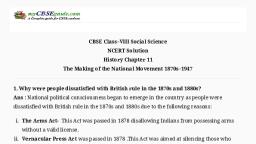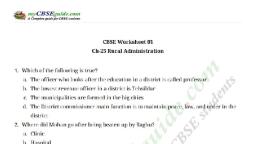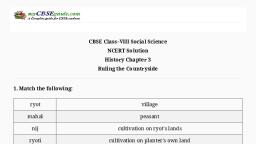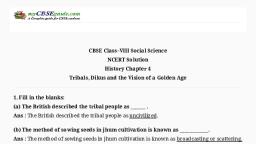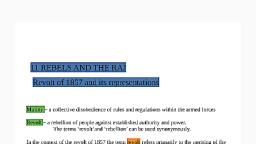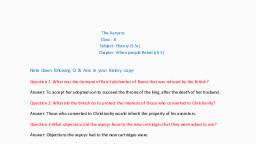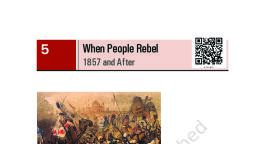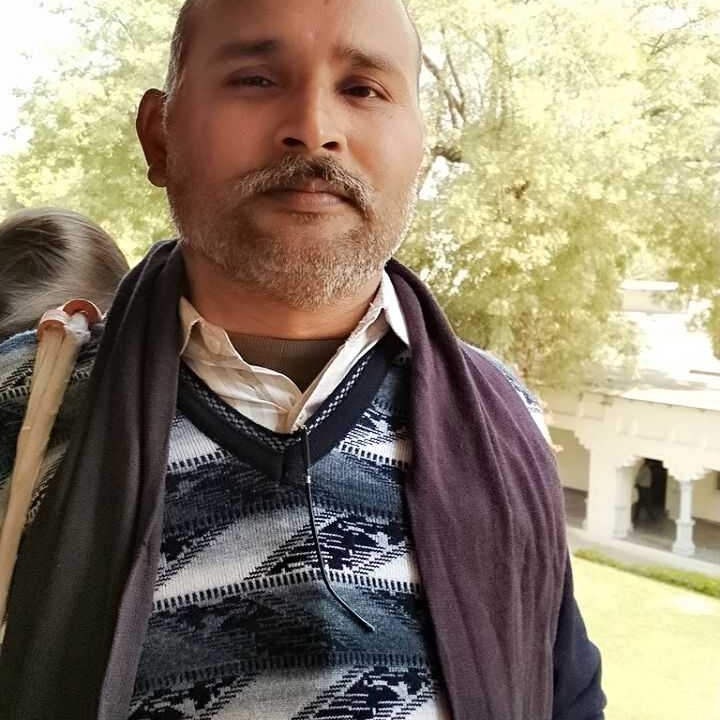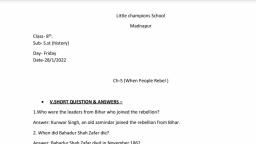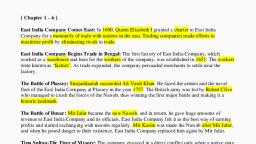Page 1 :
CBSE Class–VIII Social Science, NCERT Solution, History Chapter 5, When People Rebel, , Q1 : What was the demand of Rani Lakshmibai of Jhansi that was refused by the, British?, Ans: Rani Lakshmibai of Jhansi demanded the company to recognize her adopted son as the, heir of the kingdom after the death of her husband. But the British refused to accept her, adopted son as the ruler of Jhansi. By ‘Doctrine of Lapse’ introduced by Lord Dalhousie, if an, Indian ruler died without a male heir his kingdom would ‘lapse’ and such kingdom would be, annexed by the British Empire. However, the Company, confident of its superiority and, military powers, turned down her pleas., , Q2: What did the British do to protect the interests of those who converted to, Christianity ?, Ans:After 1830, the Company allowed Christian missionaries to function freely in its domain, and even own land and property. In 1850, a new law was passed to make conversion to, Christianity easier. This law allowed an Indian who had converted to Christianity to inherit, the property of his ancestors. Many Indians began to feel the British were destroying their, religion, their social customs and their traditional way of life., , Q3: What objections did the sepoys have to the new cartridges that they were asked to, use?, Ans: The new cartridges were suspected of being coated with the fat of cows and pigs. Both, Hindus and Muslim sepoys were offended by the introduction of these cartridges. Before, loading these cartridges in the rifles a sepoy had to bite it to open the wrapper. This affected, the religious sentiments of the Hindus and the Muslims as the Hindus consider cows as Holy, and the Muslims consider the pigs as the dirty animals. Therefore, the sepoys refused to use, these new cartridges. They felt that the British were trying to insult their religions. However,, the perception that the cartridges were tainted added to the larger suspicion that the British, were trying to undermine Indian traditional society. For their part, the British did not pay, Material downloaded from myCBSEguide.com., , 1/5
Page 2 :
enough attention to the growing level of sepoy discontent. Eighty-five sepoys were dismissed, from service and sentenced to ten years in jail for disobeying their officers., , Q4: How did the last Mughal emperor live the last years of his life?, Ans: After the death of Aurangzeb, Mughal emperors held only symbolic value., Bahadur Shah Zafar was the last Emperor of the Mughal dynasty. Although after, Aurangzeb, there was no powerful Mughal ruler but Mughal Emperors continued to, be symbolically important., In fact, when a massive rebellion against the British broke out in 1857, Bahadur Shah, Zafar, the Mughal Emperor at that time, was persuaded and declared as the leader by, the rebellions. The ageing emperor had to accept this demand., He played an important role in the revolt of 1857 against the British. Once the revolt, was suppressed Bahadur Shah Zafar was tried in court, blinded and sentenced to life, imprisonment., His sons were shot dead in cold blood before him., At last he and his wife Begum Zinat Mahal were sent to prison in Rangoon (Burma/, Mayanmaar) in October, 1858. Bahadur shah Zafar died in Rangoon jail in November,, 1862., , Q5: What could be the reasons for the confidence of the British rulers about their, position in India before May 1857?, Ans: Since the mid-eighteenth century, the power of the nawabs and rajas was on its decline., The presence of British Residents in the courts further eroded their authority and curtailed, their freedom to administer their kingdoms., From 1757 to 1857, the Company successfully annexed various Indian states, virtually, unopposed, by using a variety of political, economic and diplomatic methods. It rarely, had to use military power., There were several riots, rebellion and revolts which occurred before May, 1857. But, all these were localized and were suppressed by the British then and there., In the mid 18th century, the powers of Nawabs, rajas, zamindars etc. were eroded., The freedom of the Indian rulers was reduced, their armed forces were disbanded,, and their revenue and territories were taken by stages., Material downloaded from myCBSEguide.com., , 2/5
Page 3 :
Another reason for the confidence of the British was the decline of the Mughal, dynasty. The Company, through various measures, ensured that the dynasty came to, an end. The name of the Mughal king was removed from the coins minted by the, Company. It was also decided that Bahadur Shah would be the last Mughal king and, after his death, none of his descendents would be recognised as kings., The fact that apart from the Company there was no other dominant authority in the, Indian subcontinent and the belief that there was absolutely no threat to its authority, together contributed to its confidence about its position in India before May 1857., This is the reason why the revolt and the threatening form it took came as a shock to, the British., , Q6: What impact did Bahadur Shah Zafar’s support to the rebellion have on the people, and the ruling families?, Ans: Though the rebels were determined to bring the East India Company’s rule in country, to an end, they were faced with the question as to who would rule the land once the space of, power fell vacant., There was a wide spread impact on the people of this country and its ruling families, since Bahadur Shah Zafar accepted leadership and extended his support to the, rebellion. He asked all the chiefs and rulers of the country to come forward and, organize a confederacy of Indian states to fight the British., This single step taken by Bahadur Shah had great implications. All small and big, kingdoms, kings, Nawabs, Rajas, princes, zamindars, chiefs and even many Hindu and, Muslim religious leaders welcomed this and joined hands to rebel against the British., Regiment after regiment mutinied and started to join other troops at nodal points likeDelhi, Kanpur and Lucknow., Bahadur Shah Zafar's decision to bless the rebellion changed the entire situation, dramatically. When people saw this alternative possibly they felt inspired and, enthusiased., Many small rulers and chieftians felt that if Mughal ruler could rule again, they too, would be able to rule their own territories once more, under Mughal authority., When the rebel forces reached Red Fort, Bahadur Shah was reluctant at first to take, on the might of the British. However, he had to give in, and was thus proclaimed their, , Material downloaded from myCBSEguide.com., , 3/5
Page 4 :
leader. Having this symbolic head inspired the rebels to fight the British with, renewed confidence, hope and courage., The leadership of the Mughal emperor seemed to provide legitimacy to it. Regiment, after regiment mutinied, and joined the rebel troops at Delhi, Kanpur and Lucknow., After them, the people of various disbanded, Indian towns and villages also rose up in, rebellion and rallied around local leaders, zamindars and chiefs. This not only, strengthened the rebel forces, but also gave a national character to the rebellion., , Q7: How did the British succeed in securing the submission of the rebel landowners of, Awadh?, Ans: During the revolt, the defeat of the British forces in a number of battles caused a, number of uprisings against the British in various Indian states., A widespread popular rebellion developed in the region of Awadh in particular. The, villages took to arms and the landlords led them., The British had to fight for two years to supress the massive forces of popular, rebellion., After the defeat of the rebel forces, the British had a two-pronged strategy to suppress, the rebels and the rebellion., On the one hand, they tried and hanged a number of rebel leaders who had, challenged their authority and could do so again in the future. On the other hand,, they tried their best to win back the loyalty of the people., They announced reward for loyal landowners. They were assured that they would be, allowed to continue to enjoy traditional rights over their lands. Those who had, rebelled were told that if they submitted to the British, and if they had not killed any, white people, they would remain safe and their rights and claims to land would not be, denied., , Q8: In what ways did the British change their policies as a result of the rebellion of, 1857?, Ans: Changes in the policies of the British after the suppression of the rebellion of 1857:, British Crown took over the control of administration − The British Parliament passed, an Act in 1859, under which, the powers of the East India Company were transferred, Material downloaded from myCBSEguide.com., , 4/5
Page 5 :
to the British Crown in order to ensure a more responsible management of Indian, affairs. The Governor -General of India was given the tittle of Viceroy., The Doctrine of Lapse was abolished, the right to adoption was recognized and the, adopted son would be treated as the heir to the throne. They were made to, acknowledge the British Queen as their Sovereign Paramount. Thus the Indian rulers, were to hold their kingdoms as subordinates of the British Crown., The proportion of Indians in the English army was reduced. All important posts were, given to the Europeans only. It was decided that more soilders would be recruited, from among the Gurkhas, Sikhs and Pathans., The land and property of Muslims was confiscated on a large scale and they were, treated with suspicion and hostility. The British believed that they were responsible, for the rebellion in a big way., Policies were made to protect and safeguard the landlords and zamindars and give, them security of rights over their lands and other properties., Promised non-interference in the sphere of religion − The British assured the people, of India that their religious customs and social practices would be respected and not, interfered with., , Material downloaded from myCBSEguide.com., , 5/5

